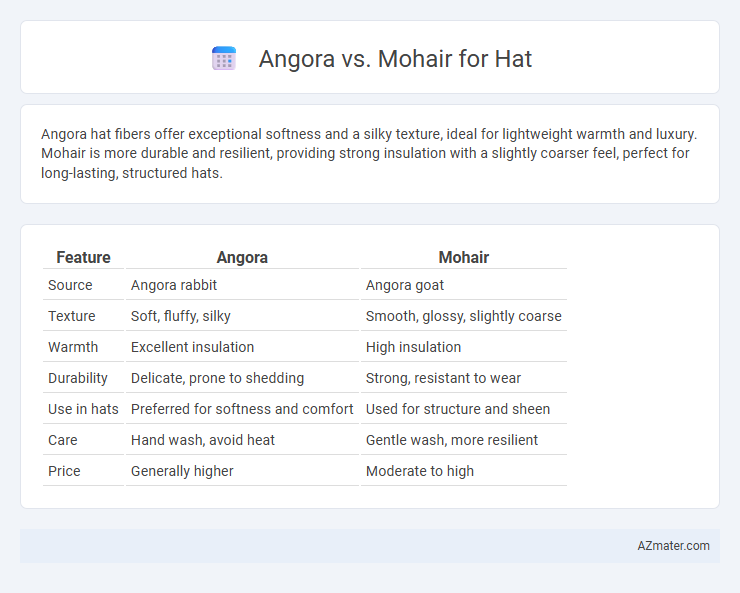Angora hat fibers offer exceptional softness and a silky texture, ideal for lightweight warmth and luxury. Mohair is more durable and resilient, providing strong insulation with a slightly coarser feel, perfect for long-lasting, structured hats.
Table of Comparison
| Feature | Angora | Mohair |
|---|---|---|
| Source | Angora rabbit | Angora goat |
| Texture | Soft, fluffy, silky | Smooth, glossy, slightly coarse |
| Warmth | Excellent insulation | High insulation |
| Durability | Delicate, prone to shedding | Strong, resistant to wear |
| Use in hats | Preferred for softness and comfort | Used for structure and sheen |
| Care | Hand wash, avoid heat | Gentle wash, more resilient |
| Price | Generally higher | Moderate to high |
Introduction: Angora vs Mohair Hats
Angora hats offer exceptional softness and a luxurious feel due to their fine fibers derived from Angora rabbits, making them ideal for delicate, warm headwear. Mohair hats, sourced from the Angora goat, provide durability and a distinctive sheen, ensuring long-lasting style and resilience. Both fibers excel in insulation and lightweight comfort, yet Angora is prized for its gentleness while Mohair is favored for strength and luster in hat construction.
Origin and Source of Angora and Mohair
Angora fiber originates from the Angora rabbit, primarily raised in regions such as France, Turkey, and the United States, renowned for its silky softness and lightweight warmth. Mohair is sourced from the Angora goat, mainly farmed in South Africa, the United States, and Turkey, prized for its durability and lustrous sheen. Both fibers are valued in hat-making for their distinct textures and insulating properties, reflecting their unique animal origins.
Fiber Characteristics: Angora vs Mohair
Angora fiber, derived from Angora rabbits, is exceptionally soft, lightweight, and has a silky texture, making it ideal for luxurious hats with a delicate feel. Mohair comes from the Angora goat and features a strong, lustrous, and durable fiber with excellent resilience and a slight sheen, providing hats with structure and longevity. Both fibers offer excellent insulation, but Angora excels in softness and warmth, while Mohair is prized for its strength and smooth, glossy appearance.
Softness and Texture Comparison
Angora fibers, derived from Angora rabbits, are renowned for their exceptional softness, often described as silky and fluffy, making hats luxuriously gentle against the skin. Mohair, sourced from the Angora goat, offers a smoother and shinier texture with a slight sheen but is generally less soft and more resilient than Angora. The difference in fiber structure causes Angora hats to have a delicate, plush feel, while Mohair hats provide a more structured and durable texture, ideal for longer wear.
Warmth and Insulation Properties
Angora fiber, harvested from Angora rabbits, provides exceptional warmth and superior insulation due to its hollow core structure that traps heat efficiently, making it ideal for winter hats. Mohair, sourced from the Angora goat, offers excellent durability and a silky texture but has a slightly lower insulating capacity compared to Angora, providing moderate warmth while maintaining breathability. Both materials excel in insulation, yet Angora's superior heat retention makes it the preferred choice for hats designed to withstand extreme cold.
Durability and Longevity
Mohair is renowned for its exceptional durability and long-lasting qualities, making it an ideal choice for hats subjected to regular wear and outdoor conditions. Angora, while softer and more luxurious, tends to be less durable and can wear down faster due to its delicate fibers. The high resilience of mohair fibers allows hats to maintain structure and appearance over time, providing better longevity compared to the more fragile angora material.
Allergies and Sensitivities
Angora, sourced from Angora rabbits, is known for its softness but can trigger allergic reactions due to the presence of lanolin and fine fibers that may irritate sensitive skin. Mohair, derived from the Angora goat, tends to be less allergenic with smoother fibers that are less likely to cause itching or respiratory issues. When selecting a hat for allergy-prone individuals, mohair is generally a safer choice due to its lower incidence of sensitivity and better hypoallergenic properties.
Care and Maintenance Tips
Angora hats require gentle hand washing with cold water and a mild detergent to maintain their softness and prevent fiber damage, while mohair hats benefit from spot cleaning and occasional dry cleaning to preserve their sheen and structure. Avoid wringing or twisting angora garments to prevent fiber breakage, and store both angora and mohair hats in a cool, dry place away from direct sunlight to prevent fading and deformation. Using a soft brush to remove dust and debris from mohair fibers helps maintain the hat's fluffy texture and prolongs its lifespan.
Style, Appearance, and Color Options
Angora hats feature a soft, fluffy texture with a luxurious sheen that enhances stylish elegance, while mohair hats offer a smooth, slightly glossy finish with a durable, silky feel favored for contemporary fashion. Angora fibers provide a natural, muted palette often in whites, grays, and soft browns, whereas mohair boasts vibrant color retention, supporting bold hues like deep reds, blues, and greens. The distinct fiber structures impact the hats' drape and warmth, making angora ideal for classic, cozy looks and mohair suitable for vibrant, structured designs.
Choosing the Best Yarn for Your Hat
Angora and mohair yarns both offer exceptional softness and warmth, but Angora provides a luxuriously silky texture ideal for delicate, cozy hats, while mohair delivers greater durability and a subtle sheen, making it perfect for stylish, long-lasting headwear. Angora fibers have a higher insulation capacity, ideal for cold climates, whereas mohair's resilience resists pilling and maintains shape over time. When choosing yarn for your hat, consider Angora for plush comfort and mohair for robust structure and elegant appearance.

Infographic: Angora vs Mohair for Hat
 azmater.com
azmater.com